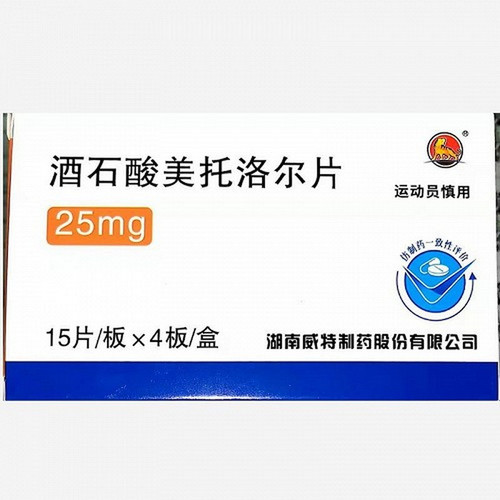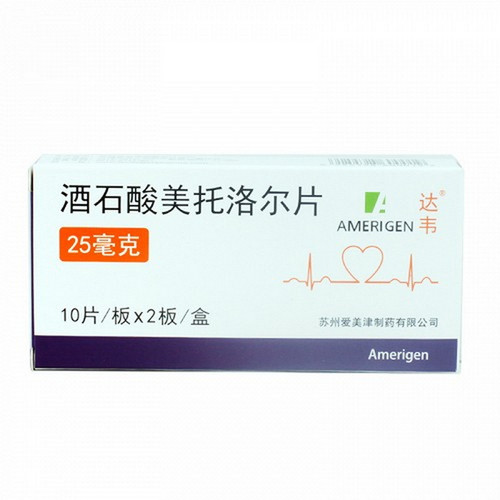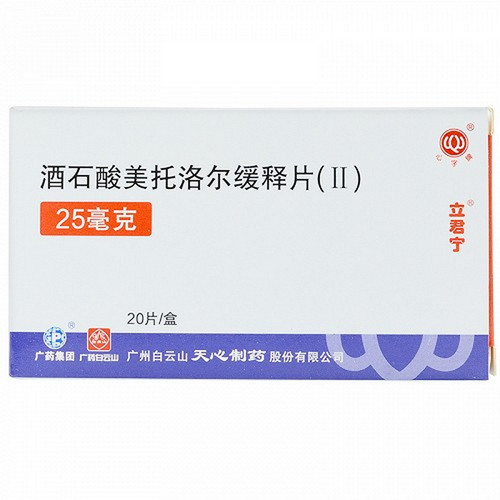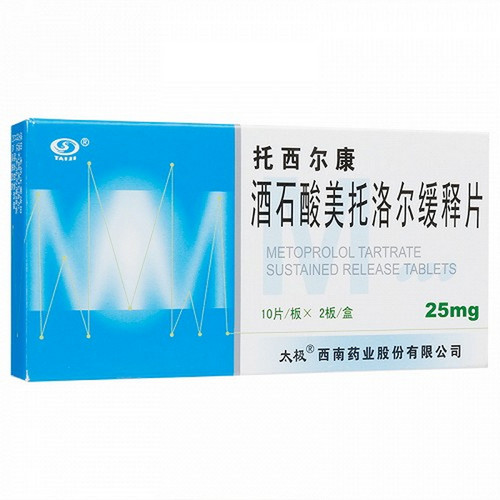Product Overview
[Drug name]
Generic name: Metoprolol tartrate tablets
Trade name: Quxin Kezhi Metoprolol tartrate tablets 25mg*24 tablets
Full code QezhMEPan22Pan
[Main ingredients]
The main ingredient of this product is metoprolol tartrate; the chemical name is: 1-isopropylamino-3-[p-(2-methoxyethyl)-propanol L (+)-tartrate.
[Properties]
This product is a white tablet
[Indications/Main functions]
It is used to treat hypertension, angina pectoris, myocardial infarction, hypertrophic cardiomyopathy, aortic dissection, arrhythmia, hyperthyroidism, cardiac neurosis, etc. In recent years, it is still used for the treatment of heart failure. At this time, it should be used under the guidance of an experienced physician.
[Specifications]
25mg*24 tablets
[Usage and dosage]
Oral. The dosage should be individualized to avoid bradycardia. The drug should be taken on an empty stomach. The bioavailability of metoprolol is increased by 40% when taken with meals. Treatment of hypertension: 10-20 mg at a time, divided into 1 or 2 doses. Acute myocardial infarction: It is recommended to use it in the early stage, that is, within the first few hours, because immediate use can reduce the infarction area and reduce short-term (15) mortality in patients who have not undergone thrombolysis (this effect appears 24 hours after taking the drug). In patients who have already undergone thrombolysis, it can reduce the reinfarction rate and re-ischemia rate. If the drug is taken within 2 hours, it can also reduce the mortality rate. General usage: First, intravenous injection of metoprolol 25-5 mg once (2 minutes meat, once every 5 minutes, a total of 3 times with a total dose of 10-15 mg, then 15 minutes later, start taking 2-50 mg orally, once every 6-12 hours, for a total of 24-48 hours, and then take 50-100 mg orally once, twice a day. Unstable angina: Early use is also advocated, and the usage and dosage can refer to acute myocardial infarction. If there are no contraindications to atrial fibrillation in acute myocardial infarction, metoprolol can be used intravenously, and the method is the same as above. If there are no contraindications after myocardial infarction, it should be used for a long time, because it has been shown that doing so can reduce cardiac mortality, including sudden death. Generally 50-100g at a time, twice a day. In the treatment of hypertension, angina pectoris, arrhythmia, hypertrophy For heart failure, 25-50 mg once, 2-3 times a day, or 100 mg once, 2 times a day. Heart failure: This drug should be used on the basis of anti-heart failure treatment such as digitalis and (or diuretics. Initially 6.25 mg once, 2-3 times a day, and then increase to 625-12.5 mg every few days to once a week, 2-3 times a day, depending on the clinical situation. The maximum dose can be 50-100 mg once, 2 times a day. The maximum dose should not exceed 300-400 mg per day.
[Adverse reactions]
The incidence of adverse reactions is about 10%, which is usually dose-related. Common (>1/100) general side effects: fatigue, headache, dizziness. Circulatory system: acral rash Cold, bradycardia, palpitations. Gastrointestinal system: abdominal pain, nausea, vomiting, diarrhea and constipation. (See the instructions inside the package for details)
[Contraindications]
Cardiogenic shock. Sick sinus syndrome. II degree atrioventricular block. Patients with unstable, decompensated heart failure (pulmonary edema, hypoperfusion or hypotension), patients receiving continuous or intermittent inotropic therapy with beta-agonists. Symptomatic bradycardia or hypotension. This product should not be given to patients with suspected acute myocardial infarction with a heart rate of <45 beats/min, a P-Q interval of 0.24 seconds or a systolic blood pressure of 100mmHg. Patients with severe peripheral vascular disease with a risk of gangrene. Allergic to any ingredient in this product or other beta-blockers. ((See the instructions inside the package for details)
[Drug Drug Interactions]
Combination with cimetidine or pre-treatment with quinidine can increase the plasma concentration of metoprolol; combination with reserpine can enhance the effect of this product, and attention should be paid to hypotension and tachycardia. (See the instructions inside the package for details)
[Precautions]
1. Propranolol can delay the recovery of blood sugar levels after the use of insulin, but this adverse reaction of selective β1-receptor blockers is smaller. It should be noted that when diabetic patients taking insulin add β-blockers, their β-receptor blocking effect often masks the symptoms of hypoglycemia such as palpitations, thereby delaying the timely detection of hypoglycemia. However, during the treatment process, the risk of selective β1-receptor blockers interfering with sugar metabolism or masking hypoglycemia is lower than that of non-selective P-receptor blockers. 2. When using this product for a long time, if you want to When interrupting treatment, the dosage must be gradually reduced, and it is generally withdrawn within 7-10 days, and at least 3 days must pass. In particular, sudden discontinuation of the drug in patients with coronary heart disease may lead to worsening of the condition, angina pectoris, myocardial infarction or ventricular tachycardia. 3. There is no consensus on whether to stop using beta-blockers before major surgery. After beta-receptor blockade, the heart's response to reflex sympathetic excitement is reduced, which increases the risk of general anesthesia and surgery, but it can be reversed with dobutamine or isoproterenol. Despite this, it is best to stop using this drug for patients who are undergoing general anesthesia, and if possible, it should be discontinued 48 hours before anesthesia. 4. When used for pheochromocytoma, alpha-receptor blockers should be used first. 5. Use with caution in case of hypotension, heart or liver dysfunction. 6. Chronic obstructive pulmonary disease and bronchopulmonary Metoprolol should be used with caution in patients with bronchial asthma. If it is necessary to use it, a small dose is appropriate, and the dose should generally be less than atenolol of the same potency. Patients with bronchial asthma should also be treated with β2 receptor agonists, and the dose can be adjusted according to the dose of metoprolol. 7. For patients with decompensated cardiac function, metoprolol should be used on the basis of treatment with digitalis and (or) diuretics. For specific usage, see (Usage and Dosage). 8. It should not be used simultaneously with verapamil to avoid bradycardia, hypotension and cardiac arrest. 9. Careful observation is required when treating patients with type 2 diabetes mellitus (DDM). 10. Athletes should use with caution. (See the instructions inside the package for details)
[Drug use in children]
Children have limited experience in using this product
[Drug use in elderly patients]
Pharmacokinetics of the elderly There is no significant change in dynamics compared with young people, so the dosage of elderly patients does not need to be adjusted.
[Overdose]
Overdose can cause significant hypotension and bradycardia. At this time, 1-2 mg of atropine can be injected intravenously, followed by metaraminol or norepinephrine. If intravenous injection of β-blockers causes serious side effects such as atrioventricular conduction block, severe bradycardia or hypotension, it can be quickly corrected by 1-5 μg/min of p-receptor agonist isoproterenol (see the instructions inside the package for details)
[Pharmacology and Toxicology]
Pharmacology: This drug belongs to Class 2A, i.e., 1-receptor blockers without partial agonist activity (cardioselective β-receptor blockers). It has a selective blocking effect on β1-receptors and has no PAA (partial agonist activity). It has no membrane stabilizing effect, and its blocking-receptor effect is about the same as that of propranolol (P), and its selectivity for B1-receptors is slightly inferior to that of atenolol. The effects of metoprolol on the heart, such as slowing heart rate, inhibiting cardiac contractility, reducing automaticity and delaying atrioventricular conduction time, are similar to those of propranolol and atenolol (AT). Its effect on reducing elevated blood pressure and heart rate during exercise tests is also similar to that of PP and AT. Its contraction effect on vascular and bronchial smooth muscle is weaker than that of PP, so its effect on the respiratory tract is also smaller, but still stronger than that of AT. Metoprolol can also reduce plasma renin activity. Toxicology: This product has no mutagenic effect; it has no effect on the fetus. Rats took 800 mg/day of this product for a total of 2 years, and no benign or malignant growths were found. (See the instructions inside the package for details)






